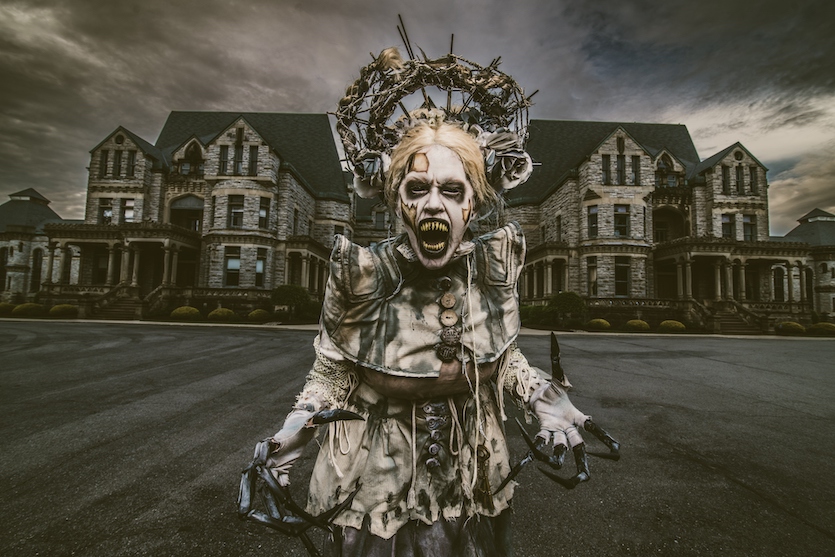
She’s no Persephone. No this denizen of the night actually is the widow of the deceased warden of Blood Prison. You’ll find her roaming the prison during the nights around Halloween. Photo courtesy of Destination Mansfield
By Teresa Bergen
As I enter the Terror Ship, the captain tells me that he and his crew have been marooned here for fifty years and all of them have a terrible virus.
I can just make out in the near darkness that something is very wrong with his face. Indeed, a closer look reveals that the virus has eaten away much of it. He warns that I will be catching it next. Which apparently happens a few minutes later, when I enter a room of swirling knee-high viral fog.
The Halloween season in Portland OR has barely started but the Underhill Manor Haunted House already is open. None of my friends wanted to accompany me, so I’m here alone walking through a dark labyrinth that’s been erected in Veterans Memorial Coliseum. There’s no Disney on Ice or Winterhawks hockey game tonight. It’s all blind turns, scary creatures emerging from velvet curtains, loud bangs, creepy organ music and screams of, “I’m infected!”
Underhill Manor is just one of many scary attractions that open in the US around Halloween. America Haunts, which runs haunted attractions around the US, estimates there are more than 3,000 haunted houses that operate as charity events. Underhill raises money for Portland’s Canon Shakespeare Company. Amusement facilities and authentic historic houses resurrect their spirits during the Halloween season. Added together these haunted attractions amass somewhere between 300 and 500 million dollars in ticket sales, estimates America Haunts. And that’s just one part of the enormous Halloween market.
Scary Halloween attractions date back to carnival freak shows and houses of mirrors, France’s Grand Guignol turn-of-the-century horror entertainment and tales of haunted houses. In 1915, the Orton and Spooner Ghost House was part of an Edwardian fair in the UK.
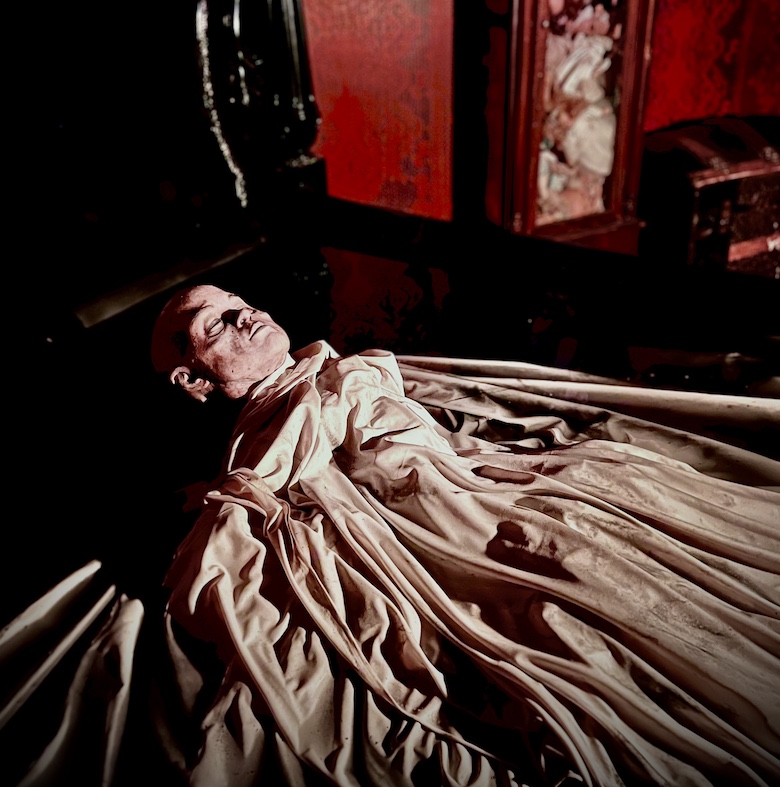
Ghouls at Underhill Manor are encouraged to take their beauty sleep, but they must rise and start haunting once the sun sets. Photo courtesy of Underhill Manor
Haunted houses went mainstream when Disneyland opened its Haunted Mansion ride in 1969. This dark ride carries visitors through spooky stage sets on little trains known as doom buggies. In the 1970s, the United States Junior Chamber, often abbreviated to the Jaycees, started creating rudimentary haunted houses in fields and abandoned buildings as fundraisers. Two men from an Illinois Jaycee chapter, Tom Hilligoss and Jim Gould, wrote a book about putting on such events. They sold 20,000 copies and became the first haunted house experts.
The 1980s brought improved special effects and a burgeoning interest in horror movies. Haunted houses got gorier. “We had a huge explosion of independently produced horror films and horror cinema, and that has created a culture in that genre that never faded and has slowly grown,” said Ira Kortum, cofounder of Underhill Mansion. Amusement parks added scary attractions. People got more and more creative, and haunted mazes, scavenger hunts, trails and hayrides came on the scene. Kortum also cited the popularity of dressing up for ComiCons as expanding interest in costuming and makeup.
A Range of Attractions
Haunted house attractions range from purpose-built sites, like Underhill Mansion in the Portland Veterans Coliseum, to historic buildings that capitalize on rumors of hauntings. In my visits to historic sites, I always ask about the presence of ghosts. Usually, staff either choose to embrace the lore or they get huffy and act like I’m disrespecting the building’s true historical value. Those who tout their paranormal past often find it lucrative, especially around Halloween.
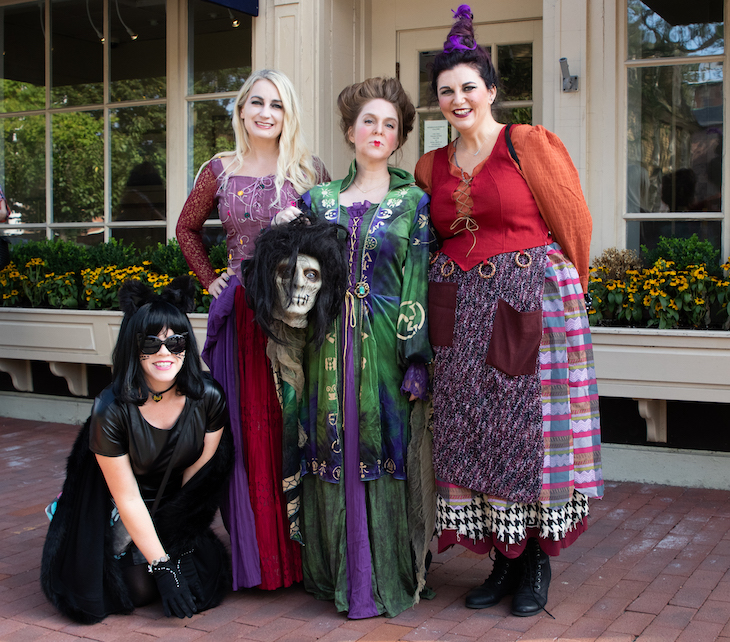
Women living in the vicinity of Salem, Massachusetts like to dress up for Salem Haunted Happenings at Halloween. These ladies are costumed to resemble Sarah Jessica Parker, Bette Midler and Kathy Najimy who played a coven of Salem witches in the 1993 film Hocus Pocus. Photo by Kate Fox for Destination Salem
If you live in Salem, Massachusetts, it’s useless to protest your haunted history. This town, known for the infamous Salem Witch Trials of 1692, goes all out with a costume ball, haunted marketplace, a 6.66 mile Devil’s Chase Road Race and special events at the Salem Witch Museum.
The American South also is infamous for ghosts, especially those relating to slavery and the Civil War. During October, visitors can take candlelight tours of McRaven House in Vicksburg, which claims to be Mississippi’s most haunted house. Dahlonega, Georgia’s ghost tours highlight Civil War soldiers playing cards in Mount Hope Cemetery, spectral girls in long white dresses, ghosts who rattle dishes and pans in restaurants on the public square, chairs and chess pieces being moved when no one was there. Other towns showcase their phantoms in a more family-friendly fashion, such as Mickey’s Not So Scary Halloween Party at Magic Kingdom Park in Kissimmee, Florida, which features Disney’s creepiest villains.
Americans are known internationally for having high rates of incarceration, with more than two million people behind bars. What’s scarier than an old rundown prison, indisputably the past home of thousands of tortured souls? Some of America’s creepiest old penitentiaries have been turned into the most over the top haunted attractions.
For example, Ohio’s Mansfield Reformatory, which during the Halloween season becomes Blood Prison. “The minute you pull into the reformatory compound, you are creeped out,” said haunt manager Victor Amesquita. “The façade alone is frightening; this massive, old, gothic structure makes you not even want to go in.”
Built in 1886 as a young men’s reformatory, it later turned into a maximum security prison and remained so until 1990, when a federal court ordered it closed due to its inhumane conditions. Many people recognize it from the movie The Shawshank Redemption. The prison has also starred in music videos and TV shows—including those about paranormal activity.
Some of Blood Prison’s characters have become semi-famous. The actress who plays the warden’s widow has more than 15.5 million views on TikTok, where she shares make-up and special effects tips and techniques for blood-curdling screams. “My goal is to give everyone an incredible show and never break character,” she said of her performance at Blood Prison. “I don’t want anyone to see me ‘being human’ and doing things most people do, like drinking water. I work hard to make sure we never take someone out of the experience.”
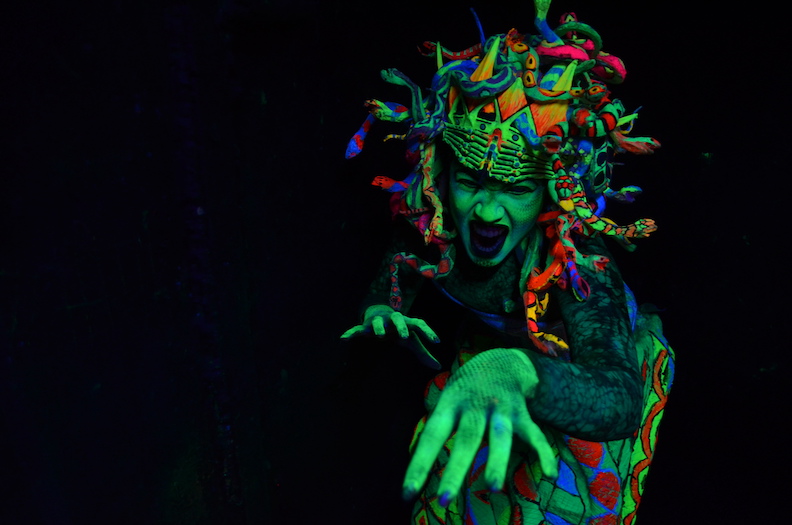
Everyone is welcomed at Eastern State Penitentiary during Halloween season by troubled spirits. Guests are encouraged to spend the night. Photo courtesy of Eastern State Penitentiary.
Philadelphia’s Eastern State Penitentiary also makes the most of a massive institution full of crumbling cellblocks. This historically important prison embodied the idea of a “penitentiary,” or place designed to inspire penitence in prisoners through grand architecture, strict discipline and lots of solitude. Its elaborate transformation for the Halloween season includes creepy haunted areas, singing vampires and a Prohibition-era speakeasy in Al Capone’s old cell, where he spent eight months for carrying a concealed weapon in 1929-1930.
Why is Halloween so Popular in the US?
Americans are obviously industrious Halloween entrepreneurs and consumers. But if you’re not enamored with the creepy, or you come from a different culture, you might be asking yourself why. Who wants to spend money seeing horrible acts simulated at depressing old places while being scared out of their gourds?
After touring Underhill Mansion, I asked a young couple why they like haunted houses. Whitney Vossen and Jordan Scrivner met last year during the spooky season and spent their early courtship touring Portland’s haunted houses. They were at Underhill to celebrate their one-year dating anniversary. “I grew up and none of my friends were into it and it was like my thing,” Vossen said. “And then we met, and he was into it, too.”
“I like the suspense,” Scrivner told me. “Occasionally you’ll have really great actor who really does a top-notch job.” He lauded a butcher at Underhill who was chopping something meaty, surrounded by 200+ plastic roaches. “He had a great laugh.”
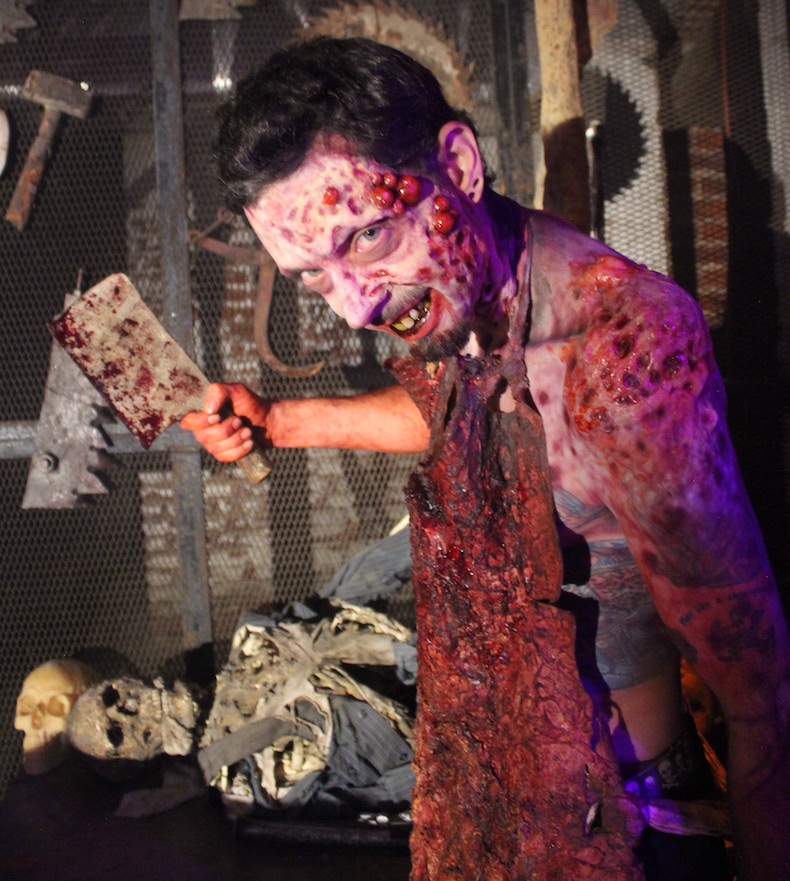
Perhaps because of its welcoming staff, Blood Prison attracts more than 35,000 visitors every Halloween. On a small town like Mansfield, Ohio, thrill-seeking tourists can have a significant economic impact. Photo courtesy of Destination Mansfield
Later, while browsing Underhill’s Halloween mart, I run into the couple again. They’re breathless with excitement over a vendor who charges five bucks to latch customers into a coffin for a couple of minutes. “You have to try it!” they both tell me.
Okay, we’d better check in with a psychologist here. Frank McAndrew, a psychology professor at Knox College has written extensively on creepy stuff. “A group of researchers at Aarhus University in Denmark have referred to this type of behavior, i.e., paying good money to go to horror movies or commercial haunted house attractions, as ‘recreational fear,’” he told Yahoo Life. “They describe recreational fear as a form of play that combines the perfect mix of fear, enjoyment, and surprise. The right combination of these emotions appears to be addictive for many people.” These scary but ultimately safe encounters with the undead make us feel alive. “Our body responds to scare attractions with a jolt of adrenaline and an increased heart rate. It seems as if we experience small, unexpected changes from our baseline level of arousal as pleasurable, but sudden, intense elevations are more likely to result in fear.”
Haunted houses can also make people braver. Christina Kortum, co-founder of Underhill Mansion, said haunted houses changed her life. She was an introverted Information Technology worker when she stumbled upon the opportunity to work in a Bay Area haunted house.
“Scaring people somehow builds your confidence,” she says. “Having a six-foot-five guy run from you screaming really helps when you’re a shy, quiet, nerdy person. I became horrifically addicted to it. And it really, really helped me come out of my shell.”
Her haunted house experience eventually led to leaving the tech world and founding Ravenous Studios, a special effects makeup company that works with the biggest names in film.
The Economics of Halloween
Halloween is second only to Christmas as the most economically significant U.S. retail holiday. The National Retail Federation [NRF] predicts spending to exceed $12.2 billion in 2023, toppling last year’s record of $10.6 billion. Consumers spend their Halloween dollars on costumes, candy, decorations and greeting cards.
According to the NRF, consumers aged 35-44 were outspending other age groups, with an average per person rate of $149.34 in 2021. And it keeps going up. In 2017, Americans spent 500 million dollars on pet costumes. That figure is projected at 700 million this year.
It’s no accident that Halloween comes in second to Christmas. As Ira Kortum points out, “It’s sort of the anti-Christmas.” Not everybody is about yuletide joy. Some prefer giant spiders and the chill of the grave. “They feel like oh, I can get behind it,” Kortum said. “This is mine.”
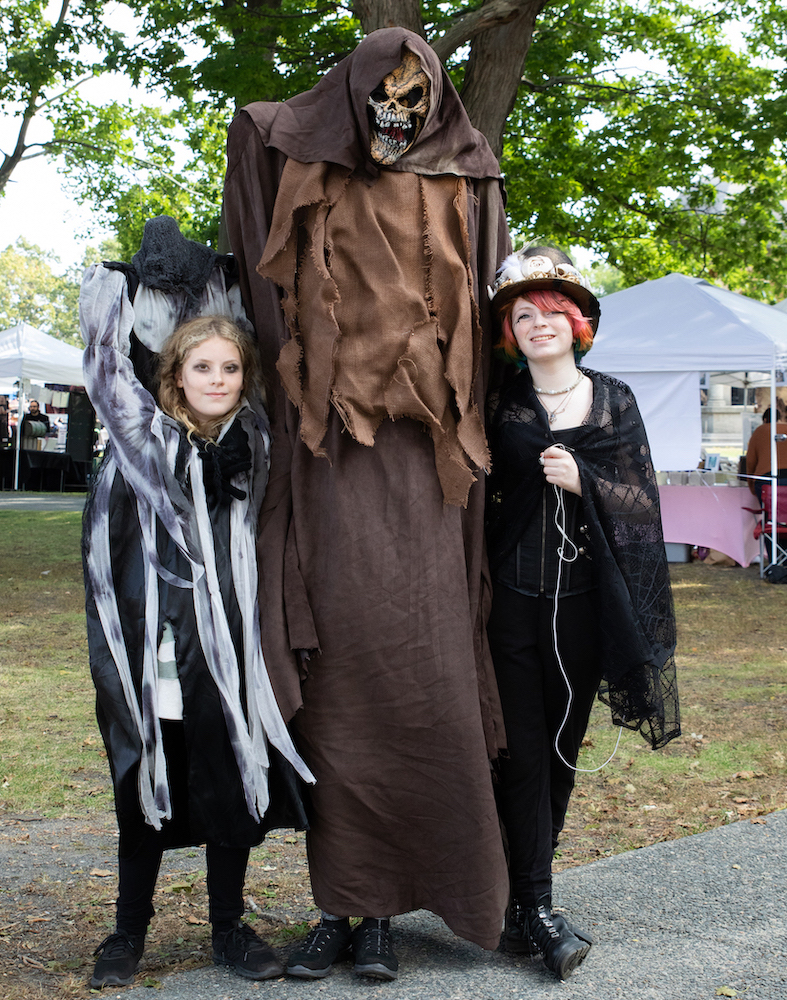
Costumed people with tall brown-robed ghoul dressing up in Salem, Massachusetts. Courtesy of Destination Salem
Haunted houses can bring a significant amount of money into a local economy. Especially if a destination is fortunate enough to have a creepy old building. “Blood Prison is just one more aspect of the value the preservation of this incredible historic prison has brought to our community,” said Destination Mansfield President Lee Tasseff. “More than 35,000 visitors come to Blood Prison every year, bringing more than $5 million annually in economic impact.”
Creepy tourism is vital to Salem, Massachusetts, with more than $151 million annually in direct visitor spending. “October is the busiest season of the year here in Salem, Massachusetts, and looking at last year’s data we can see that the city saw 2.6 million visitors across the month,” said Stacia Cooper, Interim Director of Destination Salem. That’s a huge increase from 586,000 visitors in September.
Interestingly, tourism is faster paced in October, with a lower “dwell time,” or time spent in a location, of 288 minutes per visitor in October versus 372 minutes in September. “That bump in average dwell time is a very important piece of the tourism economics puzzle,” said Cooper. “With slower dwell times comes a larger capture of revenue within Salem Massachusetts’ local economy.”
Major holidays like Halloween and Christmas cause mini-economic booms. But some people are puzzled when they see how much neighbors are spending on decorating their houses or over-the-top costumes. “Holiday spending can provide excellent examples of the economic concept of conspicuous consumption — like that neighbor who’s always driving the newest car,” Virginia Tech economics professor Jadrian Wooten told Newswise.
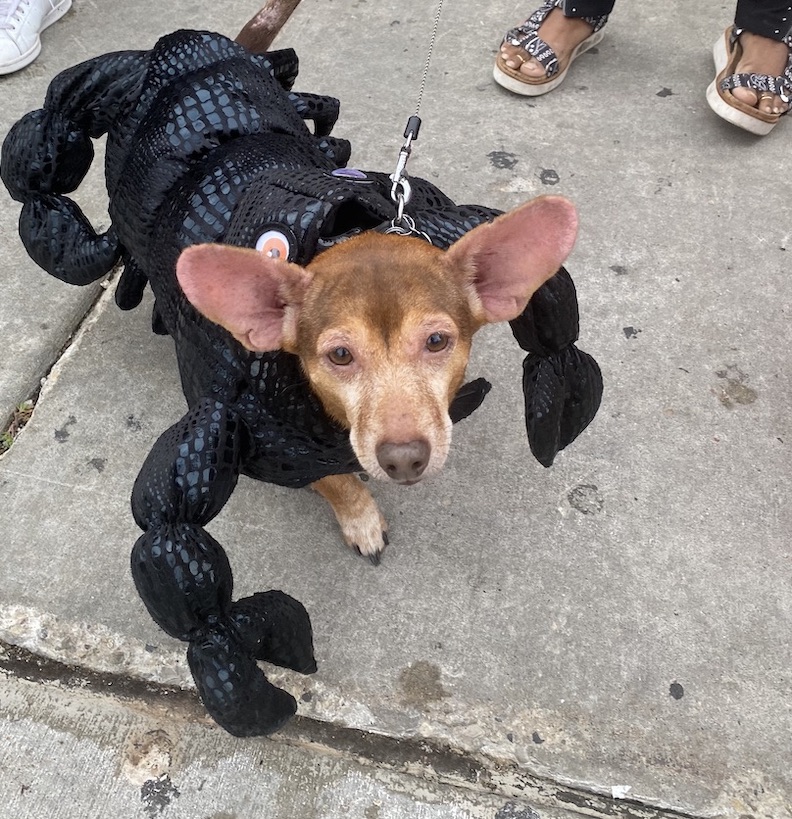
Pet costume revenues are projected to reach $700 million in 2023. This pet was in a 2021 pet costume contest in Milwaukee. Photo by Teresa Bergen.
“In the context of Halloween, it’s really easy to see this with things like pet costumes: people like dressing their dogs up as superheroes and pumpkins. It’s a classic example of people spending money on things that showcase their social status or make a statement about having disposable income. It’s a reminder that our spending isn’t always about practicality. Sometimes people do things just to have fun and show off.”
Halloween and Day of the Dead
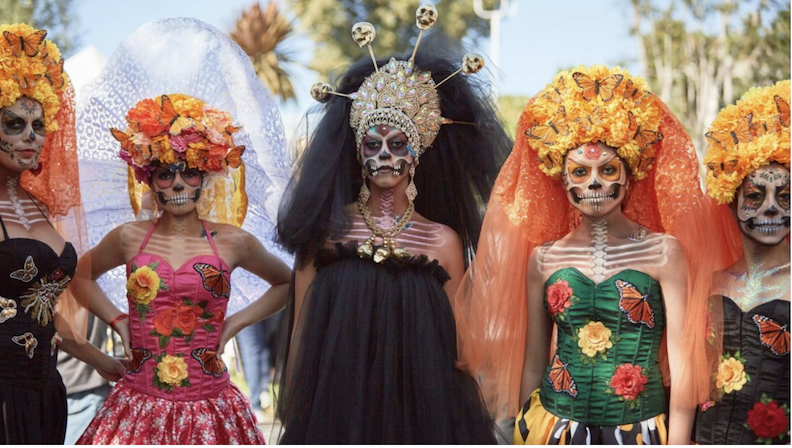
Did you see the movie Babylon? Many of the brightest stars from Hollywood’s golden age who were depicted in that film are buried in the Hollywood Forever Cemetery. Once a year on October 30 their spirits arise for a Dia de los Muertos celebration. Photo courtesy of ladyofthedead.com
Halloween and Dia de Los Muertos are not the same thing. But they fall close together on the calendar, and the macabre aspects of Dia de Los Muertos appeal to many Halloween enthusiasts. People sometimes combine them into a spooky season, despite the days taking different perspectives on death.
The Aztecs and Nahua people began celebrating the Day of the Dead thousands of years ago. Instead of mourning the dead, they kept memories of their dear departed alive with joyous celebrations. Dia de Los Muertos was the day when people believed the dead could temporarily return to Earth for a visit. In Latino communities, people set up colorful altars commemorating the dead and decorate sugar skulls. They scatter paths of marigolds to lead spirits back to their headstones, where families picnic together and listen to mariachi music.
As Diddiery Santana wrote on the University of Colorado, Denver website, “While both holidays may be considered ‘spooky,’ Halloween revolves around darkness, death, ghosts, witches, candy, and costumes. On the other hand, Day of the Dead is explicitly about the afterlife and remembrance. The skulls symbolize the continuation of memories and of life. It is a sacred time for families as it gives them peace and reassurance.”
Of course, Halloween lovers adore skulls, and lots of folks like a party, so Dia de Los Muertos has been embraced outside of Latino communities. In Los Angeles, Hollywood Forever Memorial Park holds one of the biggest Day of the Dead celebrations, with altars, tacos, a ceremonial procession and big-name entertainment. San Antonio’s Dia de los Muertos festival lasts a whole week.
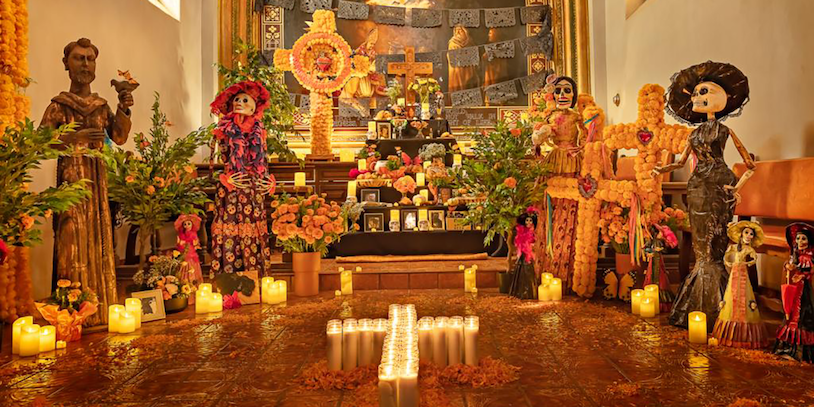
Sedona, Arizona’s Tlaquepaque art village features five days of large-scale installations and vignettes commemorating the Day of the Dead. Photo courtesy of Visit Arizona
Joining in the spooky party
Halloween started in the US but it’s spreading rapidly. “There’s a huge, huge thing in Hong Kong every year,” Christina Kortum says. “There’s a magical, fantastical haunted house in Paris that we went through that’s just amazing. In Japan, Halloween has taken off to a level that just makes America look like it’s goofing around. They have some very intense, insane multilevel haunted houses at a whole other level of professionalism.”
Not only is a little scare good fun, Christina Kortum says, but touring haunted houses supports actors and creative people. And over her thirty-year career, she’s seen a jump in professionalism. “It’s improvised theater at a giant level.” If you’ve never been to a haunted house—or haven’t visited one in a while—maybe it’s time to check out some live theater. With a dose of strobe lights, rubber spiders, spooky organ music and fake blood.![]()
In her previous East-West News Service articles, Teresa Bergen explored the Arctic Circle, autumn harvest festivals and the growing popularity of boozy cemetery picnics.

